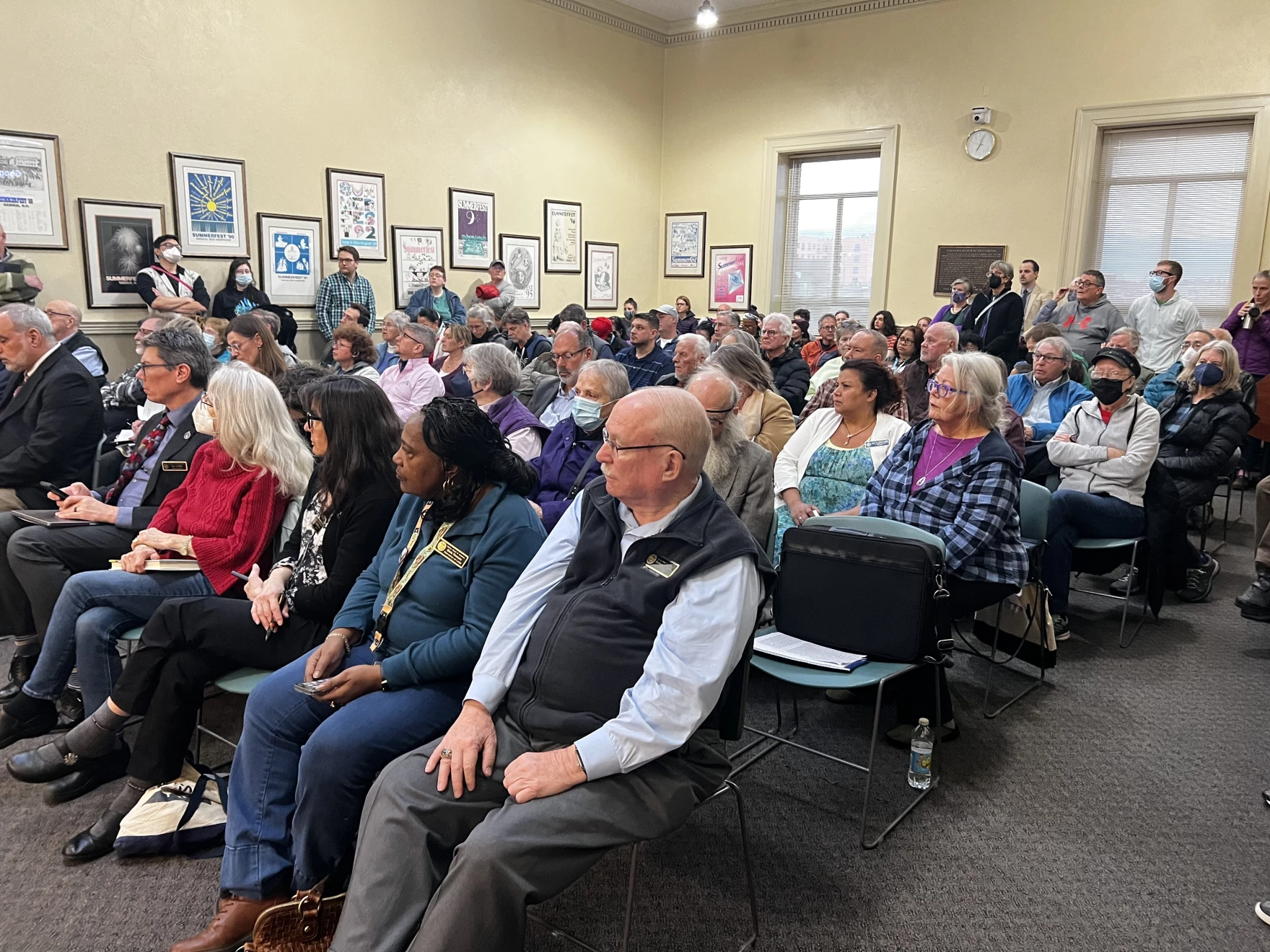The ‘No Grades No Grades’ pilot ended grade levels and letter grade scores in select schools, but none of the schools have continued that approach due to a lack of leadership, professional development, and funding.
By Kelly Burch, Granite State News Collaborative
[ED NOTE: New Hampshire is nearing the end of a more than three-year effort to revamp the state’s core educational standards. When approved early next year, these new rules will steer the course of public education for at least the next decade. In this continuing series of stories, the Granite State New Collaborative will explore what those changes are, how they came about and what they mean for the future of public education in the Granite State.]
From 2016 to 2018, six elementary and middle schools in New Hampshire got rid of grade levels and letter grades used to measure student progress.
Those steps were part of a pilot study designed to bring the schools further into competency-based education, an approach that emphasizes self-driven learning and a real-world application of knowledge.
"We had an opportunity to think differently,” said Mary Earick, dean of the School of Education at New Mexico Highlands University, who spearheaded the project known as No Grades, No Grades, or NG2. At the time, Earick was a professor at Plymouth State University.
Principals at the participating schools say they saw widespread positive changes in their students and teachers, with more collaboration, innovation and personalized learning. A research paper on the program, published by Earick, found that two of the participating schools saw referrals for individualized education plans (IEPs) and 504 plans — used to ensure that special education students and students with disabilities have the resources they need — dropped by roughly half.
“The staff really did embrace the whole idea [of] NG2 because we met our kids where they were [and] we took them where they needed to go,” said Ken Darsney, who was principal at Franklin Middle School at the time, and who now works for the Department of Education.
Despite the program’s promise, none of the schools involved still follow the NG2 model. As administrators moved on and leadership at the state Department of Education changed, the program faltered and ultimately fell apart.
Educators say considering the benefits and failures of NG2 is critical today as the state rewrites its minimum standards for public school approval in hopes of making sustainable advances in competency-based education in the Granite State.
“That’s the bane of my existence: sustainability,” Darsney said.
Mary-Earick-Dean-school-of-Ed-tiled-288x300 (School of Education at New Mexico Highlands University website)
An overview of NG2
NG2 was Earick’s brainchild. From 2013 to 2016, Earick worked for the Department of Education as the New Hampshire Director of Title 1, a federal program that supplies funding to schools with many low-income students.
At that time, New Hampshire was seen as a leader in competency-based education. Earick, who has a passion for equity, theorized that there was an opportunity to improve equity through a competency-based approach, leveraging existing Title 1 funding.
When students' learning is no longer separated by grade levels and grade-based evaluation, “it turns into the highest expectations you have ever seen, but naturally evolving,” Earick said. “That’s the equity piece.”
Earick sees equity as pivotal to competency-based education. During current revisions in the state minimum standards for public school education, many references to equity have been removed, educational advocates have pointed out.
With $120,000 in grant funding from the Department of Education for a two-year pilot, Earick approached schools that were already forward-thinking with their approach to competency-based education.
"We were very interested in and open to trying different things that might have seemed out of the box,” said Jonathan Vander Els, former principal at Memorial Elementary School in Sanborn Regional School District, one of the pilot schools. “NG2 was that — there was no question.”
Elementary schools in Rochester, Manchester, Pittsfield, and Sanborn Regional School District participated, along with Franklin’s elementary and middle schools.
Earick envisioned a scalable, sustainable system where schools that participated in the pilot would teach others how to adopt the approach. Instead, “it fell apart,” said Danielle Harvey, former principal of Pittsfield Elementary School.
Lack of sustainable, systemic change
Grade levels and academic grades are pillars of our education system, administrators say, so getting rid of them was no small feat. Earick worked closely with the pilot schools, traveling to professional conferences and schools around the country that had successfully implemented a similar approach.
“[We] were learning from the best in the world,” said Vander Els, who is now the director of collaborative learning for the New Hampshire Learning Initiative, a nonprofit focused on advancing competency-based education.
Despite that, “there are a lot of barriers that get in the way of [this approach] happening in the classroom,” said Vander Els, including state and federal policies around standardized grade-level testing, and funding.
That echoes concerns about current efforts to revamp the state’s competency-based education system. Parker-Varney School in Manchester was part of the pilot, and is often held up as an example of competency-based education done right by Fred Bramante, president of the National Center for Competency Based Learning, who is leading the revision of the minimum standards. Bramante has pointed to the NG2 program as a successful example of competency-based education.
And yet, Parker-Varney School is “no longer using that (competency-based education), because they cannot fund it,” according to a comment by Tina Philibotte, chief equity officer in Manchester School District, during a September public listening session about revising the minimum standards.
Making widespread changes in education requires “constantly provided training and support,” said Darsney. During leadership changes — within an individual school, a district, or at the Department of Education — that support and training can fall away.
“For this to really move forward, it has to happen at all levels of the system,” said Vander Els. “It has to [happen] at the policy level, [with] the district leaders, the building leaders, right to the teachers. Then we go into the communities.”
And yet, history shows that competency-based education has been unevenly applied throughout the state.
Vander Els, Darsney and Harvey all said that the schools they led did not continue the work inspired by NG2 after their departures, despite their effort to establish systemic changes that would last well beyond their tenure.
Adopting true competency-based education on a widespread scale in New Hampshire would require top-down support and funding from the state, according to Harvey, who is now principal of Strafford School in Strafford, with classes from preschool through eighth grade.
“Where is the non-negotiable professional development that’s going to help people change their mindset?” she said. “That’s how you get it to be sustainable as a state. But live free or die, we don’t do much as a state.”
Embracing mixed-age learning
Earick had hypotheses on what it would take to make NG2 work, but ultimately each district implemented changes in ways that they felt would work best for their communities.
In Pittsfield, a small rural school district, predicting staffing needs for each grade was difficult, due to fluctuations in the number of students, Harvey said.
Mixed-age classrooms offered a solution. And yet, Harvey didn’t just want to have students from two or three different grades in the same classroom — she wanted to really do away with the idea of grades levels all together.
“It’s a full mindset shift,” she said. “We really wanted to support the teachers in knowing where each kid was as an individual and how to support them to move forward in their own individual learning progression.”
To do that, Pittsfield Elementary restructured teaching blocks, doing away with lectures and making more time for students to study independently while teachers instructed small groups whose members were at similar learning levels.
Pittsfield experimented with different groupings for mixed-age classrooms and ultimately settled on a first- and second-grade class, and a third- and fourth-grade class. That gave children more time to learn critical concepts, without being labeled as behind grade level, Harvey said. Students who mastered concepts early could move on academically, while staying in the classroom with their peers, she added.
Students in these classes remained with the same instructors for two years, an educational concept known as looping. A 2018 study found that looping was associated with a significant increase in test score, especially for minority students.
“The research on looping is very, very strong,” said Darsney, of Franklin Middle School. Teachers who know a student’s strengths and weaknesses are better able to support that student, he explained.
Franklin also experimented with different age groupings under NG2. Ultimately, they settled on a cohort of students in fourth through sixth grade, and another of seventh- and eighth-graders. To stay true to the idea of no grade levels, the groups were called academies and named for the two rivers in town.
With the academies in place, the entire environment of Franklin Middle School was transformed, Darsney said. Looping gave teachers the “ability for people to collaborate, to want to problem-solve and understand kids’ needs,” he said. Teachers had more autonomy over the schedule, and were better able to handle discipline and academic issues without involving the administration.
“Because of the empowering we did for our staff, we didn’t see things unless they needed additional assistance,” Darn said.
Open-ended learning assessments, rather than grades
At Memorial Elementary School in the Sanborn Regional School District, Vander Els focused most of his attention during NG2 on thinking about evaluating students’ progress differently.
“We wanted to increase students’ ability to own their learning and understand where they are,” he said.
Rather than testing, the school used teacher observations and formative assessments, open-ended responses where students show they understand how to apply the concepts they’ve learned.
“This is the best way that they know where kids are,” Vander Els said.
The school implemented co-created assessments, where students worked alongside teachers to decide how best to demonstrate what they had learned. Projects, presentation and defenses of learning — like those used for doctoral candidates — are all examples of formative assessments.
“There were folks who didn’t believe that kids could do that,” said Vander Els, and yet, “We saw kids increasing their levels of engagement significantly, so they could really understand and own the learning that they were part of every day.”
Despite the demise of NG2, educators say the pilot will continue to have an impact on students and teachers in the state, albeit on a small scale. Many of the teachers who were at Memorial Elementary School during the pilot still use formative assessments in their classrooms, according to Vander Els, although it’s now paired with more traditional testing.
“[This] will be part of their classrooms until they stop teaching,” he said. “That’s not going to end. That’s the power of these things.”
In Franklin, mixed-age classrooms have been scaled back, but teams of fifth- and sixth-graders and seventh- and eighth-graders still learn together, according to Jule Finley, curriculum coordinator in the district.
“That’s the moral of any time you try a new education tool: looking at what is working and keeping that piece,” Finley said. “There are definitely beneficial pieces, even if the entire concept of the whole model isn’t going to be adopted.”
These articles are being shared by partners in The Granite State News Collaborative. For more information visit collaborativenh.org.
















